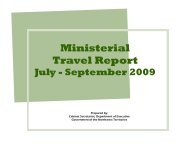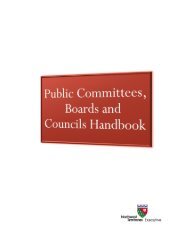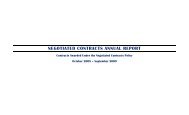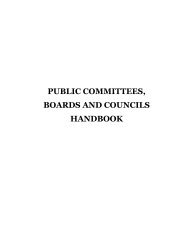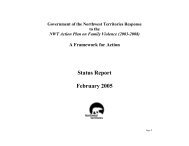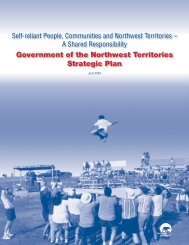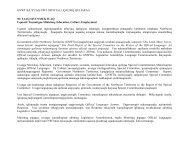Act Now - The Report of the WCB Legislative Review Panel to the
Act Now - The Report of the WCB Legislative Review Panel to the
Act Now - The Report of the WCB Legislative Review Panel to the
- No tags were found...
Create successful ePaper yourself
Turn your PDF publications into a flip-book with our unique Google optimized e-Paper software.
STAKEHOLDER QUESTIONNAIRE AND SUMMARY OF RESPONSESb) If yes <strong>to</strong> (a), what should be <strong>the</strong> definition <strong>of</strong> a shorttime?Less than 5 days at a time = 205 days at a time = 75 <strong>to</strong> 10 days at a time = 41 3 x 1 <strong>to</strong> 30 days Less than 4 months More than 10 days if <strong>the</strong>ir job crews move around (3 months) Duration <strong>of</strong> employment period 90 days 2 weeks 3 x 3 months (same as health cards) all Boards should agree on a timeframeIndustrial Classifications32. <strong>The</strong> <strong>WCB</strong> Board <strong>of</strong> Direc<strong>to</strong>rs divides employers in<strong>to</strong> industrial classes and sub-classes. For example, “services” is an industrial classand “accommodation, food and entertainment” is a sub-class within services. <strong>The</strong>re is concern about <strong>the</strong> way <strong>the</strong> <strong>WCB</strong> has classifieddifferent employers. It has been suggested that <strong>the</strong> <strong>WCB</strong> Board <strong>of</strong> Direc<strong>to</strong>rs should consult employer groups or individual employersbefore approving changes <strong>to</strong> classes or sub-classes.a) Doyou think <strong>the</strong> <strong>WCB</strong> should consult wi<strong>the</strong>mployers before changing industrial classifications?b) If yes <strong>to</strong> (a), do you think this consultation should bedescribed in <strong>the</strong> <strong>Act</strong>s?Yes = 88No = 7Yes = 74No = 1533. Under <strong>the</strong> <strong>Act</strong>s <strong>the</strong> <strong>WCB</strong> Board <strong>of</strong> Direc<strong>to</strong>rs can use different assessment rates for employers in <strong>the</strong> same industrial class or subclass.For example, <strong>the</strong> assessment rate for a company with a high accident rate could be higher than a company in <strong>the</strong> same kind <strong>of</strong> business thathas a low accident rate. A few years ago, <strong>the</strong> <strong>WCB</strong> Board <strong>of</strong> Direc<strong>to</strong>rs approved a program <strong>of</strong> penalties for employers with poor safetyrecords. Later, <strong>the</strong> Board did not feel <strong>the</strong> program was helping <strong>to</strong> meet <strong>the</strong> goal <strong>of</strong> safer workplaces and s<strong>to</strong>pped <strong>the</strong> program. It has beensuggested that a program <strong>to</strong> reward employers for establishing and maintaining safe workplaces should be reconsidered.a) Do you think a reward program for safe employers is agood idea?Yes = 89No = 4b) If yes <strong>to</strong> (a), who should approve <strong>the</strong> program? <strong>Legislative</strong> Assembly = 19Minister = 16<strong>WCB</strong> Board <strong>of</strong> Direc<strong>to</strong>rs = 62 Labour representativesAppendix C Page C21 <strong>of</strong> C33<strong>WCB</strong> <strong>Legislative</strong> <strong>Review</strong> <strong>Panel</strong> <strong>Report</strong> December, 2001




